Recent Water Damage Posts
Navigating Insurance
12/16/2024 (Permalink)
Navigating the Insurance Process After Rain Damage: SERVPRO® Can Help Protect Your Policy Against Unnecessary Claims
When heavy rain hits, it can bring more than just wet weather — it can lead to water damage in your home or business. Navigating the insurance process after rain damage can be stressful and time-consuming. That’s where SERVPRO comes in. With our expert guidance, you can avoid unnecessary claims, protect your policy, and ensure your property is restored quickly and efficiently.
1. **Understanding What Your Insurance Covers**
Not all water damage is treated equally by insurance companies. It’s crucial to know the difference between rainwater damage and flood damage. Rainwater damage often occurs when water enters your property due to roof leaks, broken windows, or seepage through foundation cracks. Flood damage, however, is typically caused by water rising from the ground and is often covered under a separate flood insurance policy.
SERVPRO’s trained professionals can help you determine the source of the water damage, which can significantly impact how your insurance claim is handled. Knowing the difference ensures you’re filing the right type of claim and not jeopardizing your policy with unnecessary or incorrect claims.
2. **Thorough Documentation of Damage**
Accurate documentation is essential when submitting an insurance claim. SERVPRO’s team arrives on-site with industry-grade tools to assess the extent of the damage. We take photos, videos, and moisture readings to create a comprehensive report that supports your insurance claim.
Our team’s thorough approach helps ensure that your insurance provider has a clear, detailed record of the damage, reducing the chance of delays or denials. Plus, having a professional third party document the damage lends credibility to your claim.
3. **Expert Mitigation to Prevent Further Damage**
One of the most common reasons insurance claims are denied is "failure to mitigate further damage." Insurance providers expect homeowners and business owners to take reasonable steps to prevent additional damage once the issue is discovered.
SERVPRO’s emergency response team is available 24/7 to provide immediate mitigation services. We’ll tarp roofs, board up windows, and extract standing water to protect your property from further harm. This proactive approach demonstrates to your insurance provider that you’ve taken necessary action, helping protect your policy from potential claim denials.
4. **Reducing the Risk of Unnecessary Claims**
Filing an insurance claim isn't always the best option. Frequent claims can increase your premiums or even lead to non-renewal of your policy. SERVPRO can assess the damage and provide an honest recommendation on whether it’s worth filing a claim.
If the damage is minor, you might be able to cover the repair costs without involving your insurance. SERVPRO’s professional advice can help you make an informed decision, saving you from filing unnecessary claims that could impact your future coverage.
5. **Direct Communication with Your Insurance Provider**
Dealing with insurance adjusters can be challenging, especially if you’re unfamiliar with the process. SERVPRO’s experienced team can act as a liaison between you and your insurance provider. We’ll communicate directly with adjusters, answer questions, and provide the documentation they need to process your claim.
This support removes a major burden from your shoulders and ensures your insurance claim moves forward as smoothly as possible. Our team’s experience in handling insurance claims can make a significant difference in the speed and outcome of your claim.
6. **Restoration and Cleanup Services**
Once your claim is approved, it’s time to restore your property. SERVPRO’s restoration services include water extraction, drying, mold remediation, and structural repairs. Our goal is to get your property back to its pre-damage condition as quickly as possible.
Our "restore vs. replace" approach saves both time and money. By restoring salvageable items instead of replacing them, we help reduce claim costs — a factor that insurance providers appreciate.
**Why Choose SERVPRO?**
SERVPRO’s experience, training, and dedication to customer service make us the go-to choice for navigating the insurance process after rain damage. Here’s why homeowners and business owners trust us:
- **24/7 Emergency Response:** We’re available around the clock to provide immediate assistance.
- **Certified Professionals:** Our team is IICRC-certified in water damage restoration, mold remediation, and other key services.
- **Trusted by Insurance Companies:** SERVPRO is a preferred vendor for many major insurance providers, meaning we’re familiar with their processes and requirements.
- **One-Stop Solution:** From damage assessment to full restoration, SERVPRO manages every step of the process.
5. Don’t wait for rain damage to happen before you prepare. Here are a few proactive steps you can take to protect your property and your insurance policy:
- **Inspect your roof and gutters** regularly for signs of wear and tear.
- **Seal windows and doors** to prevent water intrusion.
- **Address foundation cracks** before they become entry points for rainwater.
- **Document your property’s condition** with photos and videos, so you have "before" evidence if you ever need to file a claim.
**When Rain Damage Strikes, Call SERVPRO First**
Rain damage can be overwhelming, but with SERVPRO’s support, you’ll have a partner guiding you every step of the way. From damage assessment to claim support to full restoration, we’re committed to making your experience as smooth as possible.
Avoid unnecessary claims, protect your policy, and restore your property with confidence. Call SERVPRO today to learn more about our rain damage services or to schedule a consultation.
How We Can Help You In The Event Of A Flood
11/5/2024 (Permalink)
When a major flood strikes, the impact can be overwhelming and devastating. From submerged furniture and damaged appliances to structural compromises, floods can cause both emotional and financial strain. At SERVPRO®, we understand the challenges that flood victims face, and our expert team is ready to respond quickly, with compassion and professionalism, to help you restore your home or business. Here’s how SERVPRO can be your trusted partner in the aftermath of a flood.
Rapid Response and Assessment
Time is critical when dealing with flood damage. The sooner a property is assessed, the better the chances of minimizing long-term damage. SERVPRO’s 24/7 emergency response team is prepared to arrive promptly, providing a comprehensive assessment of the property to determine the extent of water damage. This initial step allows our team to develop a clear action plan and keep you informed at every stage.
Professional Water Extraction and Drying
The most immediate concern after a flood is removing water from the property. SERVPRO utilizes advanced water extraction equipment that removes even large volumes of standing water quickly and efficiently. This is followed by a thorough drying process using industrial-grade dehumidifiers and air movers to eliminate residual moisture from floors, walls, and other surfaces. This process helps to reduce the risk of further water damage and prevent mold growth.
Mold Prevention and Remediation
Floodwater and high humidity create the ideal environment for mold to grow within 24 to 48 hours. SERVPRO’s certified technicians are trained in mold remediation and use proven techniques to identify, contain, and remove mold. We also treat affected areas with antimicrobial solutions to prevent future mold growth, ensuring a healthier and safer environment as you rebuild.
Cleaning and Sanitization of Affected Items
Floodwaters often carry contaminants like sewage, chemicals, and debris. SERVPRO’s team cleans and sanitizes all salvageable items, including furniture, clothing, and personal belongings, using specialized cleaning agents and techniques. Our odor removal process eliminates any lingering smells, making your home or business feel fresh and clean again.
Structural Restoration and Reconstruction
In severe flood cases, water damage can compromise the structural integrity of a building. SERVPRO goes beyond basic cleanup by offering reconstruction services to repair damaged walls, floors, and ceilings, helping to bring your property back to its pre-flood condition. Our goal is to streamline the restoration process so you don’t have to coordinate with multiple contractors; SERVPRO is your one-stop solution from start to finish.
Assisting with Insurance Claims
Navigating insurance claims after a flood can be daunting. Our team understands the paperwork and requirements involved in making a claim, and we work closely with insurance companies to ensure that you receive the coverage and assistance you deserve. We document every step of the restoration process, providing photos and reports that make the claims process smoother and more efficient.
Why Choose SERVPRO?
SERVPRO is a trusted name in the restoration industry, with a track record of helping families and businesses recover from disasters of all sizes. Our technicians are highly trained, certified, and equipped with the latest technology to deliver the best possible outcomes. We pride ourselves on our compassionate approach, guiding you through each step of the process with clear communication and support.
---
Floods can be devastating, but you don’t have to face the recovery process alone. Whether your property has sustained minor water intrusion or extensive flood damage, SERVPRO is here to help restore your peace of mind and get you back on your feet. Reach out to SERVPRO today—our team is ready to respond and assist in making your property feel like home again.
Using state of the art technology to extract water from flooring
7/5/2024 (Permalink)
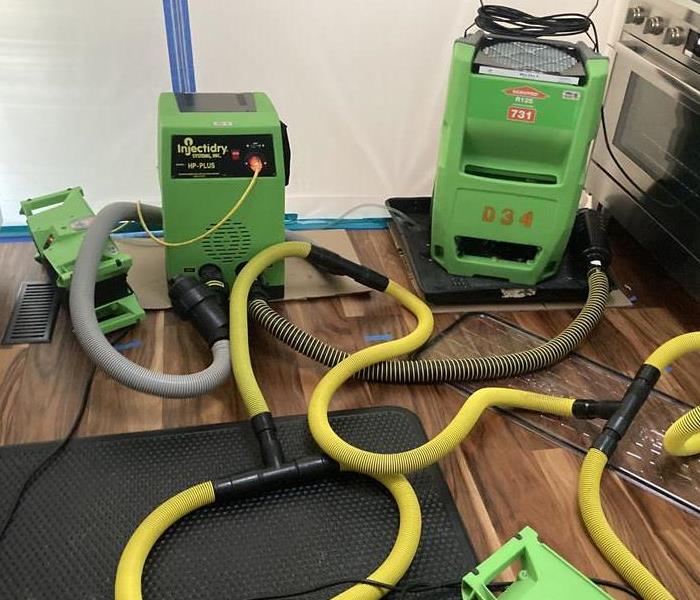 Advanced technology floor mat water removal system
Advanced technology floor mat water removal system
When disaster strikes and water damage affects a property, prompt and effective action is crucial to minimize long-term consequences. One of the leading companies in the restoration industry, SERVPRO®, utilizes advanced techniques and equipment to mitigate water damage. Among their arsenal of tools, water extraction mats play a pivotal role in efficiently removing water from flooring, especially in cases of severe flooding or water leaks.
Water extraction mats are specially designed to address water intrusion in flooring materials, including carpets, hardwood, tile, and laminate. These mats are engineered to create a vacuum seal against the floor, allowing for maximum water extraction. SERVPRO technicians deploy these mats as part of their comprehensive water damage restoration process to ensure thorough and efficient removal of water.
The process begins with a thorough assessment of the affected area. SERVPRO's trained professionals inspect the extent of water damage and determine the best approach for water extraction. Once the assessment is complete, they strategically place the water extraction mats over the saturated flooring. The mats are connected to powerful vacuum systems that create a strong suction, pulling water from the flooring and subflooring layers.
One of the key advantages of using water extraction mats is their ability to extract water from hard-to-reach areas. Traditional water extraction methods may leave behind residual moisture, especially in porous materials and beneath flooring surfaces. Water extraction mats, however, can effectively remove water from deep within the flooring, reducing the risk of mold growth and structural damage.
Moreover, the use of water extraction mats significantly speeds up the drying process. By removing a substantial amount of water quickly, SERVPRO can transition to the next phase of restoration sooner. This includes using dehumidifiers and air movers to eliminate any remaining moisture and thoroughly dry the affected area. Faster drying times not only prevent further damage but also reduce the overall restoration time, minimizing disruption to homeowners or businesses.
SERVPRO's commitment to using state-of-the-art equipment like water extraction mats demonstrates their dedication to providing top-tier restoration services. Their expertise ensures that water damage is addressed promptly and efficiently, helping property owners return to normalcy as quickly as possible. By investing in advanced technology and continuous training for their technicians, SERVPRO remains at the forefront of the restoration industry, capable of handling even the most challenging water damage scenarios.
In conclusion, water extraction mats are a crucial tool in SERVPRO's water damage restoration toolkit. Their ability to effectively and efficiently remove water from various types of flooring makes them indispensable in the fight against water damage. By leveraging this technology, SERVPRO ensures that properties are restored to their pre-damage condition with minimal disruption and maximum efficiency.
Emergency Water Clean Up
11/22/2023 (Permalink)
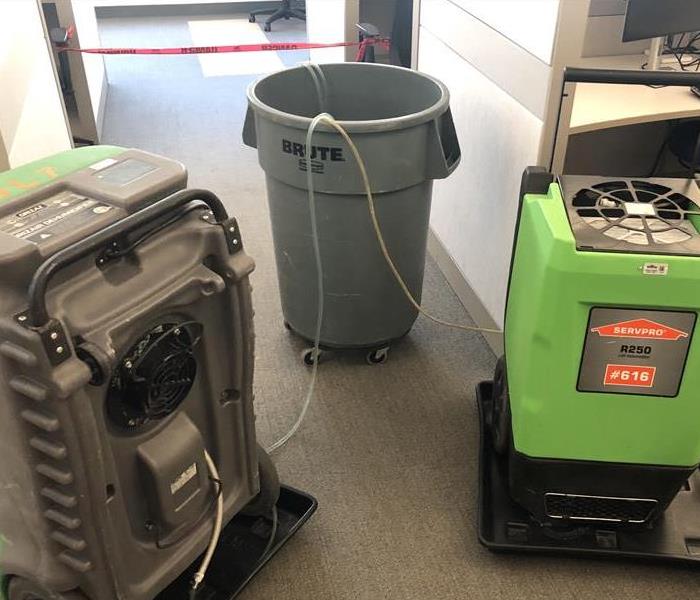 Professional grade equipment is used to dry out large, open spaces following a water leak in an office.
Professional grade equipment is used to dry out large, open spaces following a water leak in an office.
When it comes to drying out water damage, we follow a systematic process to ensure effective restoration. Here is a general overview of how SERVPRO® typically handles water damage:
1. **Emergency Contact:** The restoration process begins with a call to their emergency hotline. This allows them to gather information about the extent of the damage and dispatch a team to the site.
2. **Inspection and Damage Assessment:** Upon arrival, SERVPRO® technicians assess the extent of the water damage. This involves determining the category and classification of the water damage, which helps them create an appropriate plan for restoration.
3. **Water Removal:** The first step in drying out water damage is removing any standing water. SERVPRO® uses powerful pumps and vacuums to extract water from the affected areas. The sooner water is removed, the less damage is likely to occur.
4. **Drying and Dehumidification:** After standing water is removed, the drying process begins. Industrial-strength air movers and dehumidifiers are strategically placed to accelerate evaporation and reduce humidity. This step is crucial to prevent further damage such as mold growth.
5. **Cleaning and Sanitizing:** Once the affected areas are dry, SERVPRO® focuses on cleaning and sanitizing. This may involve cleaning carpets, upholstery, and other belongings. We also use specialized cleaning agents to disinfect and prevent microbial growth.
6. **Restoration:** The final step is restoration, which involves repairing or replacing damaged materials such as drywall, flooring, or structural components. The goal is to restore the property to its pre-damaged condition.
Throughout the entire process, SERVPRO® uses advanced monitoring equipment to track the moisture levels and ensure that the affected areas are drying properly. This helps prevent secondary damage and ensures the thoroughness of the restoration.
It's important to note that the specific steps may vary based on the unique circumstances of each water damage situation. SERVPRO® technicians are trained to adapt their approach based on the severity and type of water damage encountered. If you experience water damage, it's crucial to contact a professional restoration service promptly to mitigate the damage and prevent further issues.
Building with Care: How to Prevent Water Damage During Construction
7/24/2023 (Permalink)
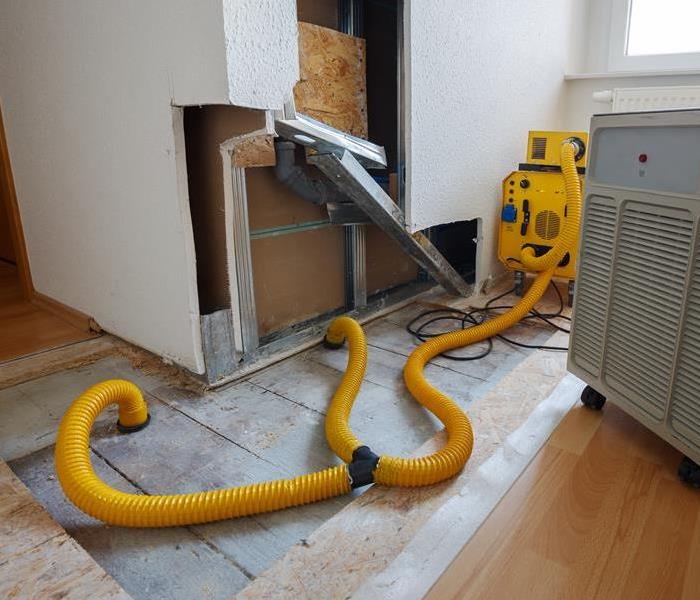 Protecting your business during construction is crucial to prevent water damage.
Protecting your business during construction is crucial to prevent water damage.
Water damage during construction can be a costly and time-consuming problem that can significantly delay a project and incur additional expenses. Taking proactive measures to prevent water damage is crucial for the successful completion of any construction project. In this blog post, we will discuss important strategies and best practices to help you prevent water damage during construction, ensuring a smooth and efficient construction process.
Create a Detailed Construction Plan
Before starting any construction project, develop a comprehensive plan that includes a thorough assessment of the site and potential water-related risks. Consider factors such as the topography, drainage patterns, and existing water sources. By understanding these factors, you can implement preventive measures tailored to the specific needs of the site.
Install Proper Drainage Systems
Effective drainage systems are essential to prevent water accumulation and potential damage. Ensure that the site is properly graded to direct water away from the construction area. Install temporary or permanent drainage systems, such as trenches, swales, or French drains, to redirect water flow and prevent pooling.
During construction, it is crucial to protect building materials from exposure to moisture. Store materials in covered areas or use waterproof coverings to shield them from rain, snow, or other sources of water. Proper storage and protection will help maintain the integrity of materials and prevent water damage.
Implement Temporary Waterproofing Measures
Utilize temporary waterproofing measures to safeguard vulnerable areas of the construction site. Apply waterproof coatings or membranes to exposed surfaces, such as foundations, walls, or roofs. Install temporary barriers, such as tarps or plastic sheeting, to protect areas where water infiltration is likely.
Regularly inspect and maintain the site's drainage systems to ensure they are functioning optimally. Clear any debris or obstructions that may impede water flow. Monitor and address any signs of poor drainage, such as standing water or erosion, promptly.
Protect Openings and Penetrations
Properly seal and protect all openings and penetrations in the building envelope to prevent water intrusion. Install temporary or permanent waterproof barriers around windows, doors, vents, and other openings. Use appropriate sealants and flashing materials to ensure a watertight seal.
Promote safe construction practices that minimize the risk of water damage. This includes covering partially completed structures overnight or during inclement weather to protect them from water exposure. Additionally, establish protocols for immediate cleanup and drying of any water spills or leaks that occur during construction.
Stay informed about weather forecasts and anticipate potential weather events that could lead to water damage. Implement precautionary measures when adverse weather conditions are expected, such as heavy rain or storms. Adjust construction schedules accordingly to avoid working during periods of high risk.
Regularly Inspect and Test Systems
Throughout the construction process, conduct regular inspections and testing of water-related systems, such as plumbing, roofing, and waterproofing installations. Identify and address any issues promptly to prevent potential water damage.
Consult and collaborate with experienced architects, engineers, and contractors who specialize in water management and construction best practices. Their expertise will ensure that proper measures are taken to prevent water damage and address any potential risks effectively.
Preventing water damage during construction requires careful planning, proactive measures, and diligent monitoring. By implementing strategies such as creating a detailed construction plan, installing proper drainage systems, protecting building materials, implementing temporary waterproofing measures, and maintaining proper site drainage, you can significantly reduce the risk of water damage and ensure a successful construction project. Taking these preventive steps will save time, money, and resources, allowing for a smooth construction process and a structurally sound building in the end.
Reasons to replace your supply lines.
3/8/2023 (Permalink)
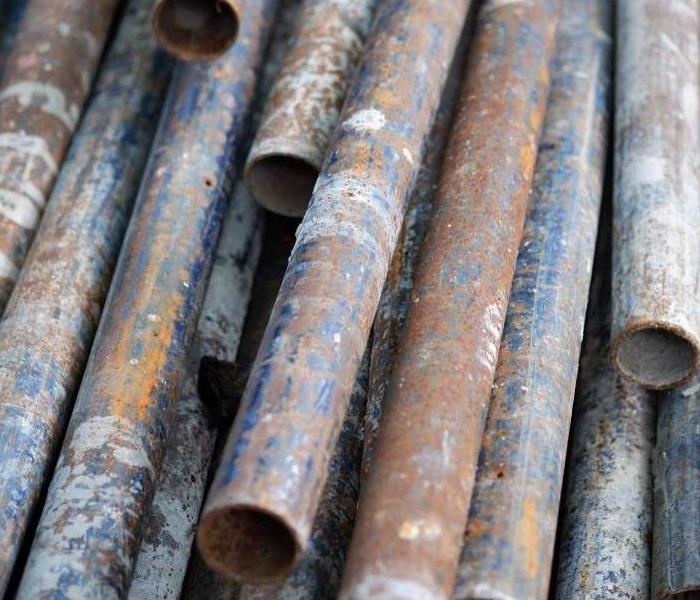 Replace old supply lines to help prevent future water damage.
Replace old supply lines to help prevent future water damage.
Water lines and pipes can be a homeowner's best friend or worst enemy, depending on how well they are maintained. It's important to know that even if your water supply line doesn't look like anything is wrong with it, it could be at risk for breaking and causing costly repairs and water damage. If you find that you have a broken supply line, it's best to replace it right away so that your home doesn't experience any further problems.
Wear and Tear
As you know, the supply lines that bring water into your home are often not visible. This means that they can break without you knowing it, causing costly repairs and water damage. In addition to this, older supply lines are more likely to break than newer ones because of their age and material (plastic).
If you have an older home with plastic piping, it's time for a change. The good news is there are many options available for replacing your old pipes with PVC or copper piping systems that have been designed specifically for homes like yours.
Overlook Damage
A supply line is the pipe that connects your home's plumbing system to the city or town's water main. The supply line is what brings fresh, clean water into your home. If a broken supply line isn't fixed quickly and properly, it can cause extensive damage to your property and lead to costly repairs.
Replace quickly
If you find that you have a broken supply line, it's best to replace it right away. Broken supply lines can be a fire hazard and can also cause water damage. Additionally, they could lead to mold and mildew growth on your walls or ceiling if not addressed immediately. Replacing the entire faucet system is expensive, but replacing just the supply lines will help prevent these issues from occurring in the future!
Even if it doesn't look like anything is wrong with them, your supply lines should be checked at least once a year. Your local SERVPRO professional can help you determine if you need new supply lines or if it's time for other maintenance such as cleaning and flushing your system. If you're unsure if your supply lines need to be replaced, contact your local SERVPRO of Campbell professional. They can help you determine if it's time for new ones or if other maintenance is needed.
How Does An Electrical Fire Happen?
12/5/2022 (Permalink)
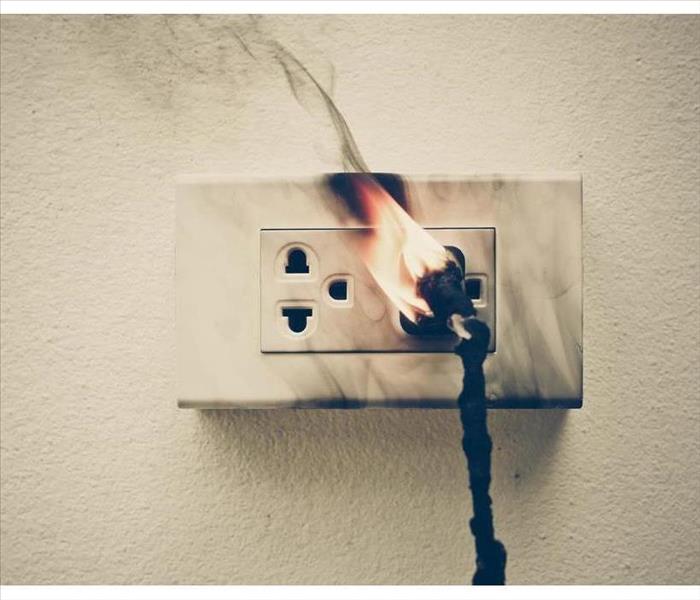 Electrical fires can be caused by short circuits.
Electrical fires can be caused by short circuits.
What Causes an Electrical Fire and How To Prevent Them?
The fact that electrical fires happen more often than most people think makes it even more important to be aware of what causes them and how to stop them. By understanding what an electrical fire is, you'll be able to spot potential problems before they start.
Electrical fires are the third most common cause of house fires in the United States.
Every year, there are over 100,000 electrical fires in homes and buildings that result in more than 400 deaths. In addition to these dire statistics, electrical fires also cause thousands of injuries every year.
The majority of electrical fires start due to wiring issues. This includes shorts or loose connections as well as faulty extension cords and power strips. Other causes include overloaded circuits, damaged cables/connectors, overloaded outlets and frayed wires on appliances or lamps.
What is an electrical fire?
An electrical fire is a fire that starts because of electricity. Electrical fires can be caused by short circuits, overloaded circuits, or overheating. Electrical fires can start in your home or office in Saratoga, CA and spread quickly. The flames from electrical fires are often very hot and may cause damage to the building's structure and contents. If you have an electrical fire, you should leave the building immediately! Then call 911 to report it.
What causes an electrical fire?
Electrical fires can occur when an electrical circuit is damaged or worn out. This can happen when wires are frayed or bent, or if the insulation is damaged on a wire. Electrical fires may also start as a result of poorly installed wiring that has not been put together correctly. In these cases, there may be exposed metal parts where they shouldn’t be, and this can cause a short circuit and fire.
Short circuits are usually caused by an electrical device that has been plugged in incorrectly or plugged into an outlet with too low of voltage for it to work properly. Another common cause of short circuits is water damage to the wiring, which causes corrosion and results in loose connections between wires inside your home's walls.
What should you do if you have an electrical fire?
If you notice an electrical fire, it's important to act immediately:
- Call 911. Electrical fires are extremely dangerous, and they can spread quickly. It's best not to attempt to put out the fire yourself in these cases.
- Stay out of the room—and keep children and pets away as well. Electrical fires release toxic fumes and may cause injury if you try to fight them yourself or if they ignite nearby objects such as carpeting or furniture that could burn through walls into other parts of your home.
- Have a fire extinguisher handy.
A final reason why an appliance might catch fire is because its internal parts have become exposed due to damage caused by normal wear-and-tear over time; this type of malfunction should always be addressed quickly so as not interfere with daily life too much since it could cause major problems down the road."
Conclusion
Electrical fires can be scary and dangerous, but they’re also preventable. If you know what to look for and how to prevent them, you can keep your home safe from electrical fire damage. The best way to avoid electrical fires is by being aware of what causes them in the first place: using extension cords or power strips that aren’t meant for high-powered appliances; overloading outlets with too many things plugged in at once; placing items on top of electrical outlets where they could potentially encounter moisture or other moisture-producing elements like basements and bathrooms.
Making a Water Damage Claim
11/7/2022 (Permalink)
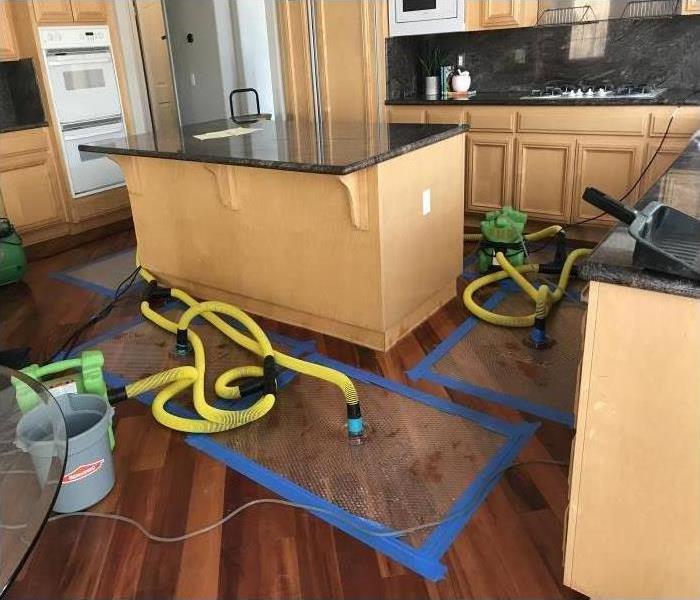 Water damage in a home in San Jose, CA
Water damage in a home in San Jose, CA
Dealing with Water Damage
The moment you realize that water is making its way into your home is a scary one. It doesn't matter if the flooding came from rain or burst pipes—the damage can be devastating and costly. Whether the water was caused by an accident or just bad luck, you'll need to act fast to get things under control. We've put together this guide to help you handle the situation and make sure your insurance company covers all of your losses.
Shut the Water Off
First, you'll want to shut off the water at the main. If you're not sure how, call a plumber—or look online for instructions on how to shut off your water supply.
The second thing is that you need to get it fixed as soon as possible. If possible, find a business in your area that specializes in repairing pipes and getting them back up and running again so that they don't burst again in the future (or worse).
While you wait for the repairman, call SERVPRO of Campbell and your insurance company, and follow these steps until help arrives:
Remove as much water as you can.
Use a wet-dry vacuum on any carpeted areas, and remove excess water with a mop. Never use a broom or brush, as they can damage the surface of your flooring. Never use towels to soak up water—they can leave lint behind that will attract dirt and bacteria in the future. Never leave fans running in your home after a flood event, because they may cause moisture damage to your ceiling or walls.
Remove the Items from Harm’s Way
When dealing with water damage, it's important to remember that your property can be replaced. Your home is not the only thing that needs to be protected; any valuable items in the area should be removed immediately and placed out of harm's way. This includes clothes, furniture, electronics, and anything else you may have in the vicinity.
If there is any damage done to your possessions - even if you aren't sure if there is or not - make sure to document as much as possible before removing them from the affected area. Take pictures of all areas where damage has occurred so that you have a visual record for insurance purposes later on when filing a claim. If there are any services required from companies like plumbers or electricians in order to fix those problems after taking out the damaged goods from their compromised areas (e.g., fixing water leaks), keep receipts for these purchases as well so that they can be added into your insurance claim if necessary
Living Arrangements
If your home in San Jose, CA is considered unlivable due to water damage, ask if your insurance will cover the cost to stay at a hotel while repairs are being made. This can be for up to 10 days if you live in an area that has been declared a disaster area by FEMA.
It's important because you don't want to return home only to see more damage happening because of lack of electricity from flooding or mold growth from not having proper ventilation and drying out time.
Don’t Wait to Call the Experts
Don't try to repair the damage yourself, and you don’t have to wait until the insurance company sends someone. You can call SERVPRO of Campbell the moment disaster strikes, and we will be out quickly to help clean up the mess and put your property back together.
The most important thing to remember is that every water damage claim is different. The process can take time and may require multiple phone calls or emails to your insurance company. If you have any questions, contact us today
Signs That You Need A Hot Water Heater Repair
8/15/2022 (Permalink)
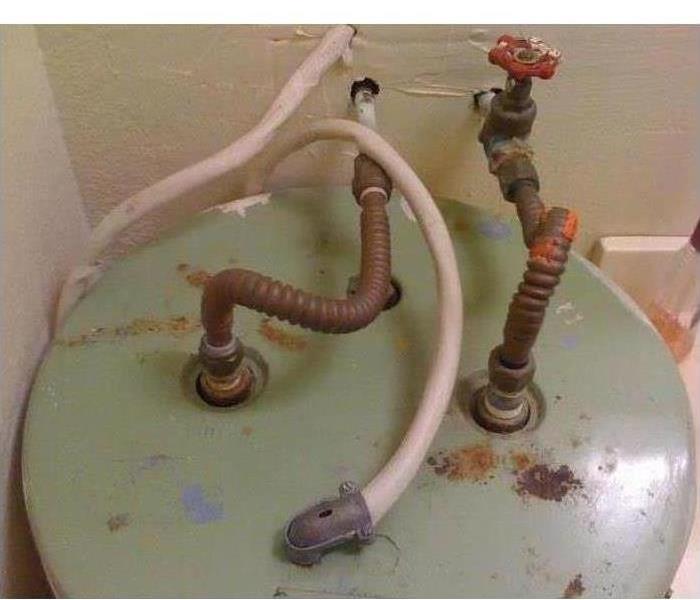 It’s important to have your water heater repaired as soon as you see these signs.
It’s important to have your water heater repaired as soon as you see these signs.
What Are The Signs Of Hot Water Heater Going Bad?
Water heaters are essential elements of our home. We use them in daily activities such as taking a bath, using the dishwasher and using the washing machine. But because we use them frequently, it’s sometimes easy to take them for granted and forget that they need to be maintained. Failing to do so will result in malfunctions and problems and eventually, replacing your water heater. Taking notice of the first signs of a problem can help you repair your water heater before it becomes worse.
You don’t have to be an expert to spot the first signs of trouble. All you need to have is a keen sense of observation so that your water heater can be repaired.
1. Hot water has an off smell or off-color. The first instance that you notice your hot water has an off smell or has a rusty color, that’s something that you need to check out. The smell could be the result of a rusty anode rod in the water heater. There is no need to worry since the anode rod can be replaced which will then eliminate the bad odor. Bacteria growth also causes bad smells. This happens when the hot water has not been used or has been turned off for quite some time or when the thermostat is set at a very low level.
2. Corroded pipes can also cause an off-color in your water. This can be solved by installing a water softener or by replacing the plumbing. If you also see a lot of sediments in the water, it’s time to have the water heater repaired.
3. Water is not hot enough, too hot, not strong enough or there is none at all. When there is no water, check first that your water heater has power and is working fine. If it is, have it inspected by a plumber. If water is not enough, this could be due to an undersized water heater and is a common situation when a lot more people are using the water heater. This could also be caused by the presence of mineral deposits inside the water heater tank. When water is too hot or not hot enough, you may have to adjust the temperature dial of the water heater. If there is no change in temperature, have the water heater checked and repaired.
4. Strange noises and leaks. Leaks coming from your water heater could lead to flooding. In the same way, strange noises like pops, bangs, gurgles, and the like are clear indicators that something is wrong with your water heater. This is usually caused by a buildup of sediments inside the tank. A boiling sound, however, could mean the water heater is overheating or that pressure is building up inside the tank. All these have to be addressed immediately to prevent further problems.
It’s important to have your water heater repaired as soon as you see these signs. This will help you save on costs, prevent further damage, and avoid an untimely replacement of your unit.
How To Minimize Water Damage After a Pipe Burst
7/13/2022 (Permalink)
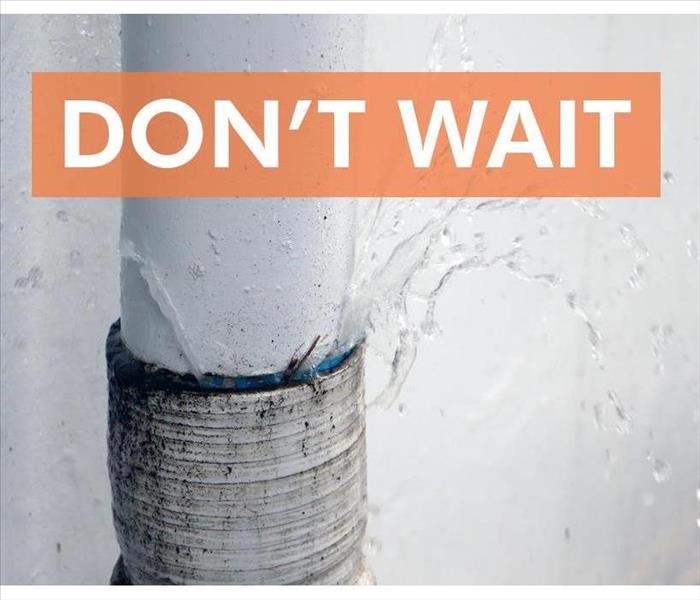 A leaking pipe will become a burst pipe causing flooding and three to five days of cleanup.
A leaking pipe will become a burst pipe causing flooding and three to five days of cleanup.
Water Damage Tips
A burst pipe is a common way that water damage can negatively affect your business. Being aware of water damage tips can help you save important items. This guide can assist you in minimizing the damage and starting the cleaning process.
Signs of a Pipe Burst
Knowing the signs of a damaged pipe is crucial to neutralize the threat of water damage before it can begin. Keep your eyes and ears peeled for:
- Knocking pipes
- Cracked or displaced tiles
- Musty or humid smells
Water Damage Tips
If you can't avoid a burst pipe, there are ways to minimize water damage to a commercial building. Start by cutting power to the affected areas of the building. Contact a building manager or the utility company if the shutoff is near an affected area.
Next, you'll want to stop the water at its source, as doing so minimizes the impact of the emergency. Contact building management if the shutoff isn’t readily available. When the water has been shut off, there will be excess flow in the pipes. Open up faucets and place buckets and containers underneath them.
Finally, collect items that are not tolerant to water exposure. Place them in water-proof containers, move them to unaffected areas, or remove them from the building altogether.
Expert Help
The cleaning tips are designed to help minimize damage, but you’ll need to call in professionals to help with the aftermath, starting with your insurance company. You'll want to ensure they keep a record of the damage.
Depending on the severity of the damage, you may require a plumber's expertise for pipe repairs. A plumber can give you tips in case anything happens in the future.
If there has been extensive water damage, you may also need assistance from a West Valley, CA, water restoration company. These businesses assess the damage and restore the building to its pre-damaged state.
Water damage can be devastating to a business. Utilizing these damage tips and services will help to create a smooth recovery process.
A Comprehensive Guide on How to Use a Fire Extinguisher
2/21/2022 (Permalink)
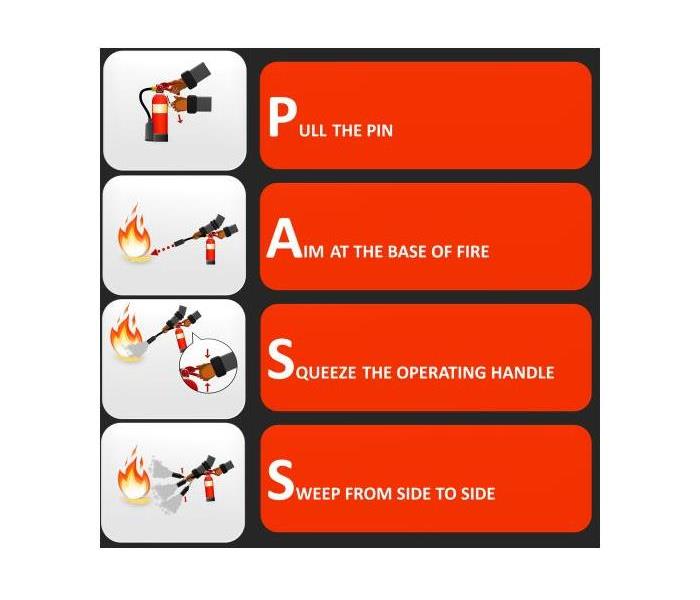 When grabbing an extinguisher, think “PASS.”
When grabbing an extinguisher, think “PASS.”
How to Use an Extinguisher
If you’ve gone your whole life thus far without knowing how to use a fire extinguisher, there’s no need to be too embarrassed! In fact, a majority of Americans claim they don’t know how to use one. Although an extinguisher is rather simple to use, you don’t want to waste time while a fire is quickly spreading in your home in Santana Row, CA. Here are the basics of how an extinguisher works, so you can act swiftly!
When grabbing an extinguisher, think “PASS.”
- Pull the pinout of the handle
- Aim the tip of the nozzle at the bottom of the fire
- Squeeze the extinguisher’s trigger
- Sweep the hose from one side to the other side until the fire is out
Once all these steps are completed, assess the fire damage and called fire restoration services if necessary.
When You Should Use a Fire Extinguisher
You will need to quickly assess the situation and make the decision to either attempt to put out the fire or run. Extinguishers can be used for small fires that just started. For example, a kitchen fire that starts while you’re cooking can easily be put out before it spreads any further. However, a large fire requires you to evacuate the area and contact the fire department.
How To Know Your Extinguisher Is Fit for the Job
There are several different extinguishers designed for different types of fires. You will need to check the label of the fire extinguisher to see if it is a Class A, B, or C. This identifies whether it is designed to handle wood and paper product fires, liquid fires, or electrical fires. Some extinguishers are identified as A-B-C and can handle all three types of fires. Also, make sure it is pressurized and charged.
If a fire ever occurs, acting as fast as possible is key to minimizing fire damage to your home. Memorize the information in this guide for the best chance of putting a fire out before it’s too big for you to handle.
How to Handle Sewer Backup
1/30/2022 (Permalink)
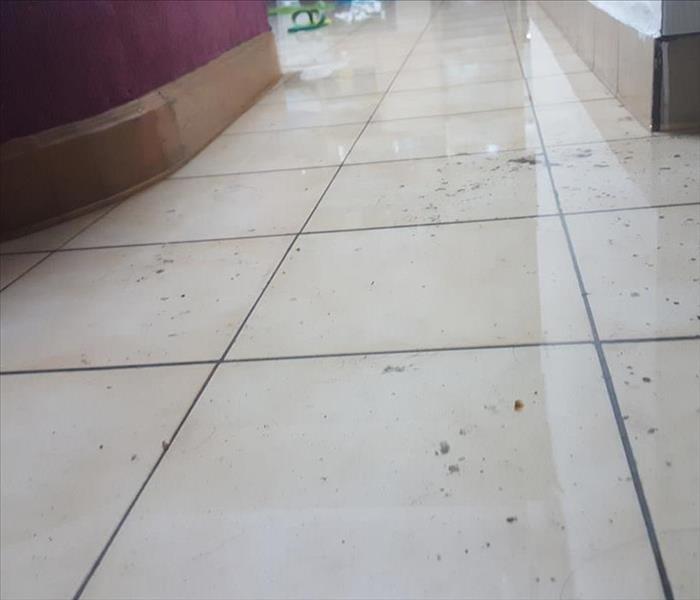 No one wants to have to go through a sewer cleanup.
No one wants to have to go through a sewer cleanup.
How to Deal with a Sewer Back-Up
Of all the dirty jobs you have to do as a homeowner, sewer cleanup is going to take the cake. When there’s a flooded toilet involved, or when a storm triggered a sewer backup, it’s time to start weighing your options. If you’re feeling overwhelmed, here is what happens during a cleanup effort:
Pump It Out and Dry It Out
All the gunk that comes along with a sewer cleanup has to be taken out. You or your cleanup professional will have to start the process right away. Often, sump or trash pumps will be used to clear the water from your home. Then, with the use of fans and dehumidifiers, your residence will be dried.
Restoration and Carpet Repair
Carpets have to be considered in the sewer cleanup. Most of the time, carpets are not able to be saved, they have to be replaced after coming in contact with sewer backup. However, there are cases where they may be able to be salvaged. In these instances, the carpets have to be removed and scrubbed thoroughly. Remember that moisture is a breeding ground for mold, and when it comes to porous belongings, there are places for the mold to hide. Everything must be disinfected and cleaned.
Odor Elimination
The problem after sewer cleanup is that sometimes you still have to figure out what to do about the smell. The cleanup process will remove most of the scent, but not always all of it. If you find that the odor is lingering in your home, you can utilize HEPA air filters to clean the air and air fresheners to make the situation tolerable. Over time, the smell should fade.
No one wants to have to go through a sewer cleanup. It can be a difficult task, but when taken seriously and with the help of specialists in Saratoga, CA, your home can be clean again in no time.






 24/7 Emergency Service
24/7 Emergency Service








